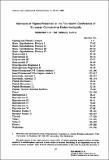Por favor, use este identificador para citar o enlazar a este item:
http://hdl.handle.net/10261/253556COMPARTIR / EXPORTAR:
 SHARE
BASE SHARE
BASE
|
|
| Visualizar otros formatos: MARC | Dublin Core | RDF | ORE | MODS | METS | DIDL | DATACITE | |

| Título: | Photoperiodic effects on vitellogenesis, steroid-hormone levels, and spawning time in the female sea bass (Dicentrarchus labrax) |
Autor: | Zanuy, Silvia CSIC ORCID ; Prat, Francisco CSIC ORCID ; Bromage, Niall; Carrillo, Manuel CSIC ORCID; Serrano, Roque CSIC ORCID | Fecha de publicación: | 1989 | Editor: | Elsevier | Citación: | General and Comparative Endocrinology 74: 253-253 (1989) | Resumen: | Previously, we have shown that the timing of spawning in the sea bass, which in eastern Spain (4O”N lat) occurs in February/March under natural conditions, can be altered by photoperiodic manipulation. However, the nature of the photoperiodic cue and the stage(s) of development affected in this response remains unclear. These questions are further investigated in the present study where different groups of 20 male and female sea bass were exposed to 1 month of long days (lSL:9D) in May (Group C), June (D), or July (E) in an otherwise constant short day (9L: 15D) photoperiod regime. Further groups were exposed to short days throughout (Group A) and to ambient light (controls). Temperature varied between 13°C in winter to 25°C in summer and fish were fed ad libitum daily with fresh trash fish. In control fish plasma estradiol (E3 and testosterone (T) levels rose in September/October followed closely by increases in vitellogenin (Vg, as calcium); E, and T values both fell toward basal levels by the end of spawning (March) whereas Vg levels were not reduced until April. Long days in May produced advancements in the timing of the seasonal changes of E2, T, and Vg compared to controls. Similar but less advanced changes in these parameters were seen in Group D, followed in timing by those in Groups E and A. In each case Vg incorporation into the cocytes began when Ca levels reached 14-15 n&%. The profde of spawning was most advanced in Group C followed by D, E, and A and then the controls. Collectively, these data indicate that ovarian development in the sea bass is controlled by hormonal mechanisms whose timing can be altered by photoperiodic change. | Descripción: | Resumen del trabajo presentado en la 14th Conference of European Comparative Endocrinologists, celebrada en Salzburgo (Austria), del 4 al 9 de septiembre de 1988 | Versión del editor: | http://dx.doi.org/10.1016/0016-6480(89)90218-9 | URI: | http://hdl.handle.net/10261/253556 | DOI: | 10.1016/0016-6480(89)90218-9 | Identificadores: | doi: 10.1016/0016-6480(89)90218-9 issn: 0016-6480 |
| Aparece en las colecciones: | (IATS) Comunicaciones congresos |
Ficheros en este ítem:
| Fichero | Descripción | Tamaño | Formato | |
|---|---|---|---|---|
| Photoperiodic effects on vitellogenesis, steroid hormone levels and spawning time in the female sea bass (Dicentrarchus labrax).pdf | 158,79 kB | Adobe PDF |  Visualizar/Abrir |
CORE Recommender
Page view(s)
36
checked on 02-may-2024
Download(s)
48
checked on 02-may-2024
Google ScholarTM
Check
Altmetric
Altmetric
NOTA: Los ítems de Digital.CSIC están protegidos por copyright, con todos los derechos reservados, a menos que se indique lo contrario.
